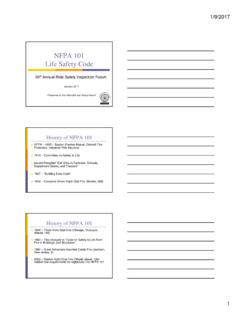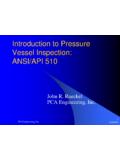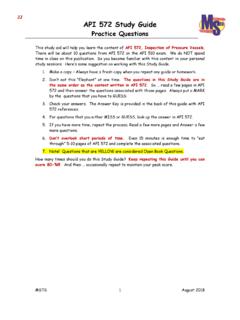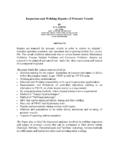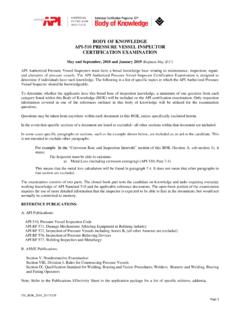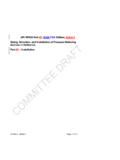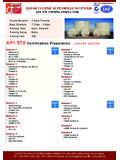Transcription of Pressure Vessel Inspections
1 Pressure Vessel Inspections ASME American Society of Mechanical Engineers Pressure Vessel Definition article provides you the definition and boundaries of Pressure Vessel based api code and ASME code . Based on the ASME code Section VIII, Pressure vessels are containers for the containment of Pressure , either internal or external. The ASME code is a construction code for Pressure vessels and contains mandatory requirements, specific prohibitions and non-mandatory guidance for Pressure Vessel materials, design, fabrication, examination, inspection , testing, and certification. Pressure Vessel Definition - Scope These scopes are based ASME code Sec VIII Div 1 The Vessel with maximum allowable working Pressure (MAWP) higher than 15 psi Inside diameter to be higher than 152 mm No piping or piping component No rotating or reciprocating Equipment Not Water Vessel up to 300psi or 210 F Not within the scope of other Sections Vessel MAWP Vessel MAWP represents the maximum safe Pressure holding capacity of the Vessel .
2 Vessel MAWP is measured at top-most point and is lowest of Vessel part MAWPs, adjusted for hydrostatic head. Boundaries The welding end of the first circumferential joint for welded connections The first threaded joint for screwed connections The face of the first flange for bolted, flanged connections The first sealing surface for proprietary connections or fittings Non Pressure parts welded directly to a Pressure retaining surface Pressure retaining covers Pressure relief devices What is api code Definition from Pressure Vessel ? Contrary of ASME code Sec VIII, which was developed for construction, the API STD 510 covers the in-service inspection , repair, alteration, and rerating activities for Pressure vessels.
3 This inspection code applies to all refining and chemical process vessels that have been placed in service. ASME code Section 8 The ASME code Section 8 is the construction code for Pressure Vessel and covers design, manufacturing and Pressure Vessel inspection ASME code Section 8 ASME code Section 8 has three divisions. Division 1 covers Pressure up to 3000 psi, Division 2 has an alternative rule and covers up to 10,000 psi Division 3 can be used for Pressure higher than 10,000 psi. Hierarchy of Standard Law and Regulation at Location of Installation Mandatory application of ASME Pressure Vessel code is determined by rule and regulation at location of installation. Regulation by Location Mandatory Minnesota Not Mandatory South Carolina ASME Boiler and Pressure Vessel code the ASME code generally is divided into three groups as following: Group 1: Construction Codes Some of them are: Section VIII for Pressure Vessel , Section I for Power Boiler, section III for Nuclear Power Plant and Section IV for heating Boiler ASME Boiler and Pressure Vessel code Group 2: Reference Codes These are the codes which are referenced from construction codes as explained in group 1.
4 The ASME Section IX for welding and Section V for Non Destructive Testing are in this Group. For example, ASME code section VIII for welding requirement such as WPS (Welding Procedure Specification), PQR (Procedure Qualification Record), Welder Performance Qualification, etc. refer you to ASME Section IX. ASME Boiler and Pressure Vessel code Group 3: In-Service Codes These are the codes for in-service inspection after placing the equipment into service. The ASME Section VI for the heating boiler and Section VII are from this group. National Board inspection code (NBIC): ASME has a separate section for Heating Boilers, the NBIC is making certification for ASME Authorized Inspectors and is also certifying R stamp for Repair services for stamped Pressure vessels.
5 This section is divided into three Subsections, Mandatory Appendices, and Nonmandatory Appendices. Subsection A consists of Part UG, covering the general requirements applicable to all Pressure vessels. This section is divided into three Subsections, Mandatory Appendices, and Nonmandatory Appendices. Subsection B covers specific requirements that are applicable to the various methods used in the fabrication of Pressure vessels. It consists of Parts UW, UF, and UB dealing with welded, forged, and brazed methods, respectively. This section is divided into three Subsections, Mandatory Appendices, and Nonmandatory Appendices. Subsection C covers specific requirements applicable to the several classes of materials used in Pressure Vessel construction.
6 It consists of Parts UCS, UNF, UHA, UCI, UCL, UCD, UHT, ULW, and ULT dealing with carbon and low alloy steels, nonferrous metals, high alloy steels, cast iron, clad and lined material, cast ductile iron, ferritic steels with properties enhanced by heat treatment, layered construction, and low temperature materials, respectively. Summary of Important Points in ASME code Section 8 [just a few] Category A: - All longitudinal welds in shell and nozzles. - All welds in heads, Hemisph-head to shell weld joint Category B: - All circumferential welds in shell and nozzles - Head to shell joint (other than Hemisph.) Category C and D are flange welds and nozzle attachment welds respectively.
7 Summary of Important Points in ASME code Section 8 [just a few] Category B: - All circumferential welds in shell and nozzles - Head to shell joint (other than Hemisph.) Category C and D are flange welds and nozzle attachment welds respectively. Summary of Important Points in ASME code Section 8 [just a few] Hydro-Test is Standard Pressure test on Completed Vessels. Hyd. Test Pr. = x MAWP x stress ratio Insp. Pressure (hydro) = test pr. / Min. Test temp. = MDMT + 30 F Max. inspection temp. = 120 F Pneumatic test is performed if hydro is not possible due to design or process reasons. Prior to the test, NDT as per UW-50 is mandatory. Pneumatic test Pressure = x MAWP x stress ratio, Pressure should be increased in steps (Total 6).
8 1st step 50% of test Pressure 2nd to 6 step 10% of test Pressure Insp. Pr. (pneumatic) = test Pressure inspection points Creep and Creep Failures What is creep? Creep may be defined as a time-dependent deformation at elevated temperature and constant stress. It follows, then, that a failure from such a condition is referred to as a creep failure or, occasionally, a stress rupture. Creep and Creep Failures Creep failures are characterized by: bulging or blisters in the tube thick-edged fractures often with very little obvious ductility longitudinal "stress cracks" in either or both ID and OD oxide scales external or internal oxide-scale thicknesses that suggest higher-than-expected temperatures intergranular voids and cracks in the microstructure Relief Valves Often Overlooked The most neglected safety device on Pressure vessels is the relief valve.
9 It is imperative that the relief valve be inspected regularly relief valve is constructed to relieve either Pressure or temperature, manually testing the valve with the test lever only tests the mechanical freedom of movement of the valve and ensures the waterways are clear. [this test may change the proper setting of the valve] Manufacturers recommend that valves that have been in service more than three years be removed and visually inspected for accumulations of corrosion deposits, such as those shown in the photographs. The probe should be inspected for corrosion and scale accumulations which will insulate the valve and probe from the tanks internals , and also for any illegal alterations, repairs or tampering.
10 Leaking relief valves must be replaced. Don't become a statistic; conduct regular routine Inspections and correct all of the deficiencies discovered Pressure Vessel Fatigue Section VIII, Division 2 of the ASME Boiler and Pressure Vessel code (ASME 2010) defines fatigue as .. conditions leading to fracture under repeated or fluctuating stresses having a maximum value less than the tensile strength of the material. (1 Pressure Vessel Fatigue Fatigue damage in a metal is a progressive, localized, permanent structural change. This article takes a more detailed look at metal fatigue including testing for fatigue, conditions affecting fatigue life of a Pressure Vessel , and examining vessels for signs of fatigue.)
